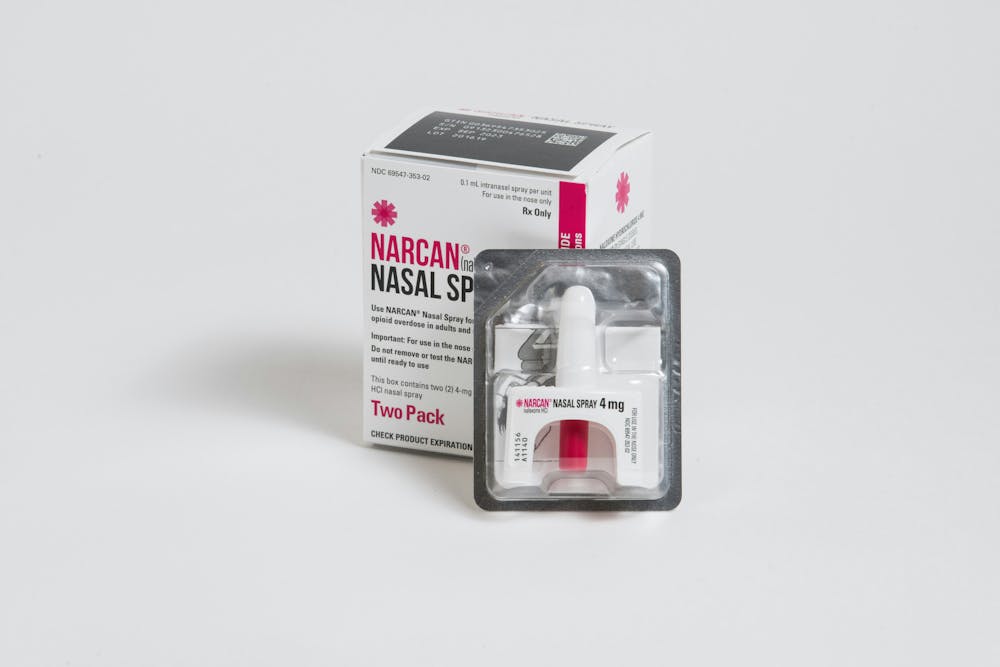Dr. Mark Quale, an emergency medical physician at Alamance Regional Hospital and EMS medical director in Alamance County, said he estimates that he sees one overdose patient each day on average. Quale said what would have been a normal dosage of heroin for an unsuspecting opioid addict turns lethal when mixed with even the smallest amount of fentanyl.
“Most of the overdoses from fentanyl happen without the victim even knowing what they are taking,” Quale said. “Because of that, it’s hard to exactly know what percentage of overdoses are actually from fentanyl.”
Fentanyl is a drug often other drugs are laced with, it’s difficult to attribute the exact number of overdoses to fentanyl. However, it is one of the main catalysts for overdoses in the Alamance area, according to data from the Vital Registry System of the State Center for Health Statistics.
The main weapon used to fight opioid overdose is the drug Naloxone. Typically known under its brand name “Narcan,” Naloxone binds to opioid receptors in the brain, blocking and reversing the effects of the opioid in an overdose case, according to the Substance Abuse and Mental Health Services Administration.
While Narcan is a strong counter to drug overdoses, adding resources to be proactive rather than reactive to overdoses is a top priority in Alamance County. The Alamance Crisis Diversion Center, a project announced in September 2022 and set to open early this year, is hoping to add more proactive resources.
Quale said he hopes this new center will bridge the gap between medical care and mental health rehabilitation. He said this will help overdose victims and prevent future overdoses by giving care to those with substance abuse issues.
In his nine years as a medical professional, Quale said he has seen the number of overdoses skyrocket in the past few years. He said it has turned into a regular occurrence for him and other doctors working in the emergency room.
Alamance County is no stranger to overdose victims with 28.3 overdose deaths per 100,000 residents between 2017 and 2021. Overdose deaths in 2021 in the county also increased 22%, according to the NC Department of Health and Human Services.
“What’s dangerous about fentanyl is how it attacks the patient’s breathing,” Quale said. “We have to make sure that the patient is able to breathe after an overdose. We usually will use a ventilator or a bag valve mask to make sure the patient regains the ability to breath.”
There are different ways of administering Narcan to a patient experiencing an overdose, including through IV. However, the most common and easiest method is through a Narcan nasal spray.
Michael Tyler, a volunteer EMT in Goochland County, Virginia, said Narcan is an extremely useful drug since there is little risk of harming the patient it is used on.
“The only concern is when they wake up, they can be super aggressive,” Tyler said. “They go into fight or flight because their last memory was them about to die, and they’re like ‘let me not die. How do I keep myself from dying?’”
Tyler said while there is not a major fentanyl issue in his county, there has been an emphasis on training EMTs for overdose victims due to the national epidemic. He said there has been an increase in both narcan training and supply.
Donald Reuss, senior vice president provider of network operations at VAYA health, said the Alamance Crisis Diversion Center is aimed to help provide increased and centralized access, prevention and recovery to the Alamance County community.
One resource that the center will use to help those with substance abuse problems is a 16-bed residential facility where people can stay for up to two weeks. Reuss said that the facility is meant to be a place where people can detox, deal with their crisis and get stable.
“[It’s] a hub for support in the county to keep individuals with mental health, substance abuse, out of your jails, out of the emergency rooms, supporting them in their local communities and making sure they [are] connected with the right services and support as opposed to going with unmet needs,” Reuss said at the Alamance County Commissioners meeting on Nov. 6, 2023.


